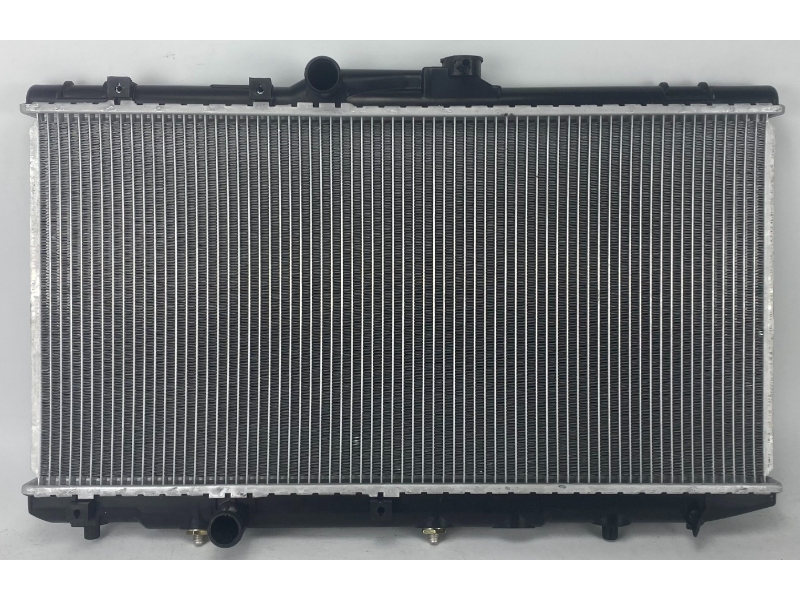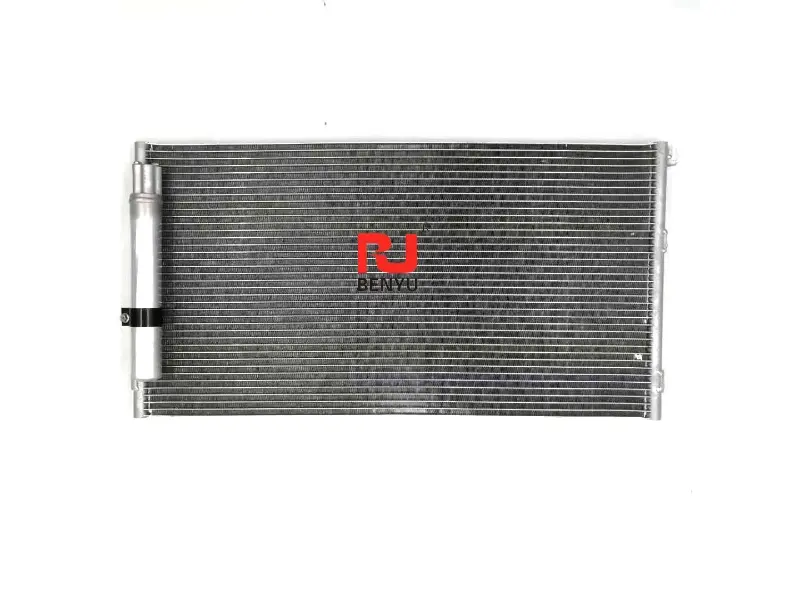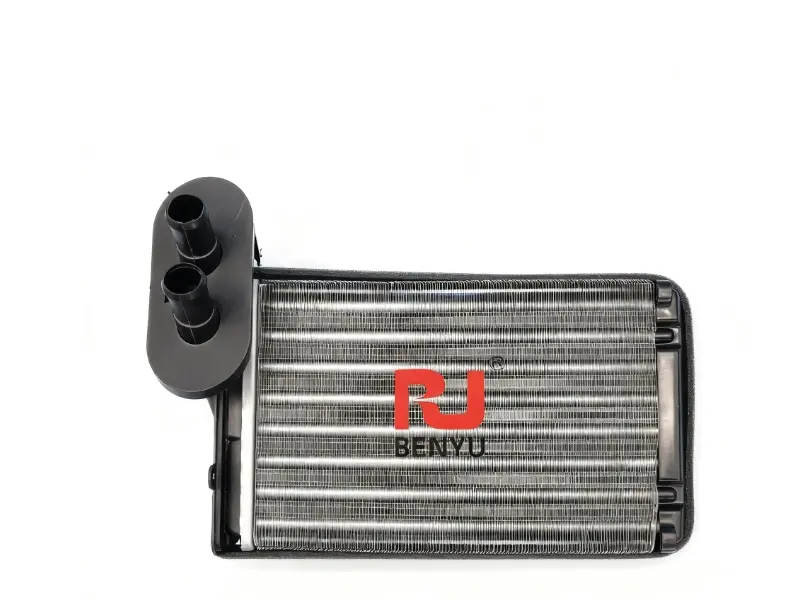كيف يعمل مبرد السيارة؟
وقت الإصدار: 2025-10-15
جدول المحتويات
ال مبرد السيارة يُعدّ المبرد (رادياتير) أحد المكونات الأساسية في كل مركبة، وله دورٌ بالغ الأهمية في ضمان بقاء درجة حرارة المحرك ضمن النطاق الآمن لمنع ارتفاع درجة حرارته. يُعدّ المبرد جزءًا أساسيًا من نظام تبريد المركبة، وعمله السليم ضروريٌّ لعمر المحرك وأداء المركبة. ستُفصّل هذه المقالة مبدأ عمل مبرد السيارة، ومكوناته الرئيسية، وكيف يُساعد في الحفاظ على درجة حرارة تشغيل مثالية للمركبة.

مبدأ عمل مبرد السيارة الأساسي
الأساسيات مبدأ عمل مبرد السيارة الأمر بسيط: ينقل الحرارة الزائدة الناتجة عن المحرك إلى الهواء الخارجي، مما يمنع ارتفاع درجة حرارة المحرك. تحديدًا، عندما يحرق المحرك الوقود، يُولّد كمية كبيرة من الحرارة، والتي تنتقل إلى سائل التبريد. يتدفق سائل التبريد (مزيج من الماء ومضاد التجمد) عبر المحرك، ممتصًا الحرارة ومخفضًا درجة حرارته.
يتدفق سائل التبريد الساخن عبر قلب المبرد، حيث تسمح الزعانف المعدنية الموجودة داخل المبرد بتبديد الحرارة في الهواء المحيط. ثم يُعاد سائل التبريد إلى المحرك لمواصلة الدورة.
عملية التبريد في مبرد السيارة
- المحرك يولد الحرارة:عندما يعمل المحرك، فإنه يولد قدرًا كبيرًا من الحرارة بسبب احتراق الوقود، والتي يجب تبديدها من خلال نظام التبريد لمنع ارتفاع درجة الحرارة.
- يمتص سائل التبريد الحرارة:يتدفق سائل التبريد، وهو عبارة عن خليط من الماء ومضاد التجمد، عبر المحرك ويمتص الحرارة الناتجة عن الاحتراق.
- يتدفق سائل التبريد إلى الرادياتير:يُوجَّه سائل التبريد المُسخَّن إلى قلب المُشعِّر. داخل المُشعِّر، يمرُّ سائل التبريد عبر زعانف معدنية، حيث تُطلَق الحرارة إلى الهواء المُحيط.
- الهواء يبرد سائل التبريد:تعمل مروحة المبرد على سحب الهواء الخارجي إلى المبرد، حيث يتلامس مع سائل التبريد، مما يؤدي إلى تبديد الحرارة وتبريد السائل.
- عودة سائل التبريد إلى المحرك:ثم يتم إرجاع سائل التبريد المبرد إلى المحرك، لمواصلة الدورة للحفاظ على المحرك ضمن درجة حرارة تشغيل آمنة.
المكونات الرئيسية لمبرد السيارة
يتكون المبرد من عدة مكونات رئيسية، يلعب كل منها دورًا هامًا في عملية التبريد. فيما يلي الأجزاء الرئيسية للمبرد:
- قلب المبردالقلب هو الجزء المركزي من المبرد، وعادةً ما يكون مصنوعًا من النحاس أو الألومنيوم، مزودًا بزعانف معدنية رفيعة متعددة مصممة لتسريع تبديد الحرارة. يتدفق سائل التبريد عبر القلب، ويمتص الحرارة، ثم يطلقها عبر الزعانف في الهواء.
- غطاء الضغط:يعمل غطاء الضغط الخاص بالمبرد على إغلاق نظام التبريد، مما يحافظ على الضغط لمنع غليان سائل التبريد وتحسين كفاءة النظام.
- خزانات المدخل والمخرج:تتصل هذه الخزانات بقلب المبرد وهي مسؤولة عن توجيه سائل التبريد الساخن إلى المبرد وسائل التبريد المبرد مرة أخرى إلى المحرك.
- خراطيم المبرد:هذه الخراطيم المرنة تربط المحرك بالمبرد، مما يسمح بتدفق سائل التبريد داخل وخارج المبرد لعملية تبادل الحرارة.
أهمية مبرد السيارة
المبرد ليس مجرد جهاز تبريد بسيط، بل يلعب دورًا حيويًا في ضمان تشغيل المحرك بكفاءة:
- يمنع ارتفاع درجة الحرارةارتفاع درجة حرارة المحرك بشكل مفرط قد يُسبب تآكلًا مفرطًا لأجزاء المحرك، أو تلفًا في الزيت، أو حتى عطلًا في المحرك. يُساعد المبرد على الحفاظ على درجة حرارة آمنة للمحرك، مما يمنع حدوث مثل هذه المشاكل.
- يحسن أداء السيارةعندما يعمل المحرك في درجة الحرارة المثالية، يعمل بكفاءة أعلى، مع كفاءة وقود أفضل وقوة أكثر ثباتًا. يساعد المبرد على إبقاء المحرك في هذه الحالة المثالية.
- إطالة عمر المحرك:التبريد الفعال لا يمنع ارتفاع درجة الحرارة فحسب، بل يقلل أيضًا من تآكل المكونات الداخلية، وبالتالي إطالة العمر الإجمالي للمحرك.
مشاكل شائعة في مبرد السيارة وصيانته
نظراً للاستخدام المستمر للمبرد، قد يواجه العديد من المشاكل مع مرور الوقت. فيما يلي بعض مشاكل المبرد الشائعة وأعراضها:
- تسربات سائل التبريدقد يؤدي تشقق المبرد أو ارتخاء الخراطيم إلى تسرب سائل التبريد. هذا يُقلل من مستوى سائل التبريد، مما يُضعف كفاءة التبريد، وقد يؤدي إلى ارتفاع درجة حرارة المحرك.
- انسداد قلب الرادياتير:إذا تراكمت الأوساخ أو الصدأ أو الرواسب داخل المبرد، فسوف يعيق تدفق سائل التبريد، مما يؤدي إلى انخفاض كفاءة التبريد وزيادة درجة حرارة المحرك.
- شذوذ درجات الحرارة:إذا تعطل المبرد، فقد ترتفع درجة حرارة المحرك بشكل غير طبيعي، مما قد يؤدي إلى تشغيل ضوء تحذير درجة الحرارة على لوحة القيادة.
- أصوات غير عادية:إذا حدث خلل في مضخة الماء أو المروحة الخاصة بالمبرد، فقد يصدر عنه أصوات غريبة، مما قد يشير إلى وجود مشكلات في عملية التبريد.
لضمان عمل المبرد الخاص بك دائمًا بأفضل حالاته، يوصى بالتحقق بانتظام من مستويات سائل التبريد، وفحص لون سائل التبريد ونظافته، والتأكد من أن المبرد خالٍ من التسريبات والأضرار.
خاتمة
المبرد هو عنصر أساسي مكون نظام تبريد السيارةيلعب المبرد دورًا أساسيًا في الحفاظ على درجة حرارة المحرك ضمن نطاق آمن، وإطالة عمره، وتحسين أداء السيارة. إن فهم آلية عمل المبرد والوعي بالأعطال المحتملة يساعد مالكي السيارات على الحفاظ على سياراتهم في حالة مثالية.
لضمان عمل مبردك دائمًا بكفاءة عالية، من الضروري إجراء فحوصات وصيانة دورية. إذا كانت لديك أي أسئلة حول مبردك أو أي مكونات أخرى لنظام التبريد، فلا تتردد في الاتصال بنا. اتصل بـ BENWOOوسنقدم لك أفضل الحلول.
تشمل مكونات نظام التبريد التي نقدمها ما يلي:
تتخصص شركة BENWOO في إنتاج قطع غيار السيارات، بما في ذلك المبردات، والمكثفات، والسخانات، والمبردات الداخلية، ومبردات الزيت. تغطي خطوط إنتاجنا أكثر من 4800 طراز من الطرازات اليابانية، والكورية، والأوروبية، والأمريكية، والصينية. نقدم خطوط إنتاج شاملة وعالية الجودة وبأسعار تنافسية. نصدر منتجاتنا بشكل رئيسي، ونتوسع بنشاط في السوق العالمية.


